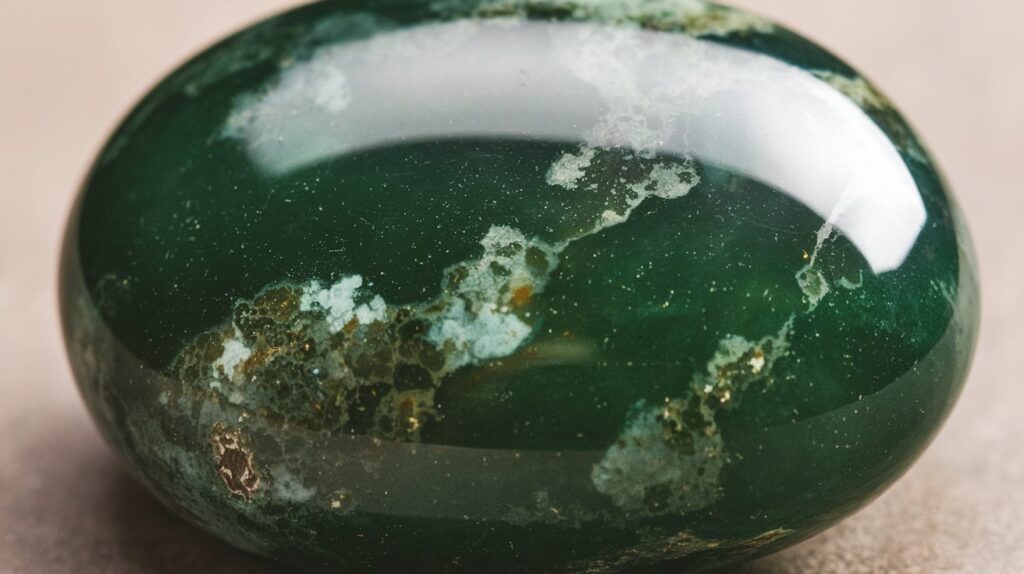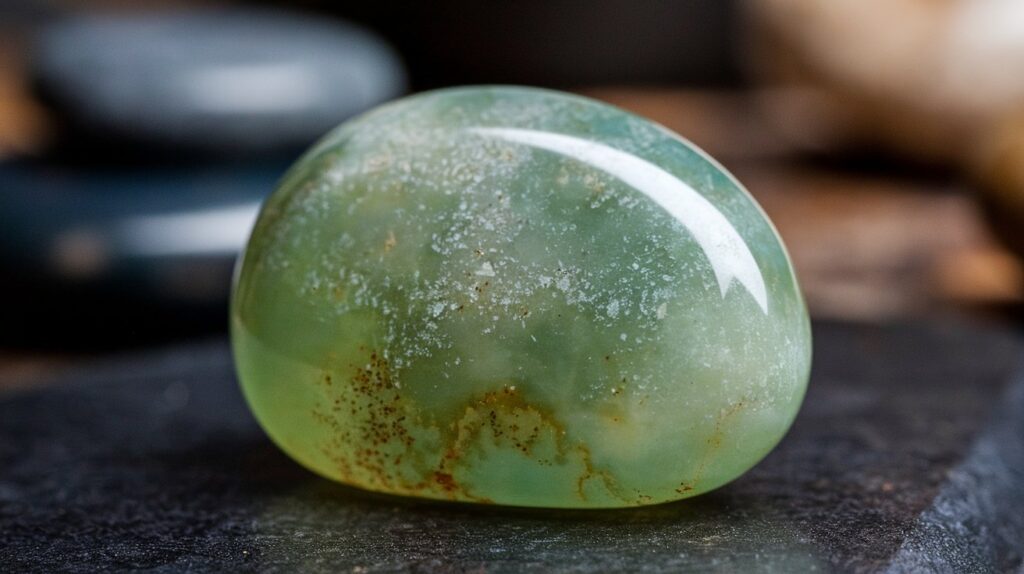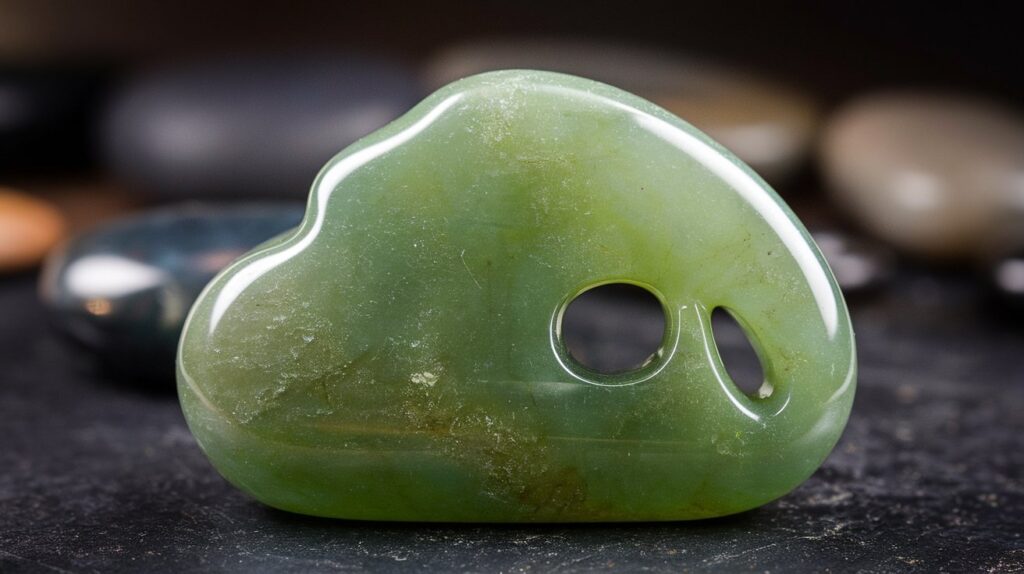
Introduction
Jade, the striking green gemstone prized for centuries, is not just a beautiful stone but one rich in history and culture. Found in many cultures and worn as jewelry or used in art, jade has been an essential part of human life for millennia. Whether it’s the traditional jade jewelry of Asia or the modern uses in fashion, this gem holds immense value in multiple contexts.
What is Jade?
Jade is a gemstone that can be made up of two different metamorphic rocks: jadeitite and nephrite. Both of these contain silicate minerals, and they’re highly regarded for their beauty and durability. The unique green color of jade is what makes it stand out, and it is often used in ornaments such as necklaces, bracelets, and sculptures.
Jade is a precious gemstone that has been cherished for thousands of years across different cultures, particularly in Asia and Mesoamerica. The term “jade” refers to two different types of minerals: jadeite and nephrite, both of which are metamorphic rocks that contain silicate minerals. These minerals are often confused because of their similar appearance, but they differ in composition, hardness, and value. Below is a detailed overview of jade, including its types, uses, history, and significance.
1. Types of Jade
Jade comes in two distinct forms: jadeite and nephrite.
- Jadeite: This is the rarer and more valuable type of jade. It is primarily found in Myanmar (Burma), which is the most famous source of high-quality jadeite. Jadeite is harder and denser than nephrite and can come in a range of colors, though it is most prized for its deep emerald green variety, known as imperial jade. Jadeite also appears in shades of lavender, white, pink, yellow, and gray.
- Nephrite: Nephrite is more abundant than jadeite and has been used in various cultures for thousands of years. It is typically creamy white or green in color, but it can also appear in shades of brown, black, and yellow. Nephrite is softer and more fibrous in structure than jadeite, but it is still remarkably tough, which made it ideal for tools and weapons in ancient times.
| Property | Jadeite | Nephrite |
|---|---|---|
| Hardness | 6.5-7 on the Mohs scale | 6-6.5 on the Mohs scale |
| Composition | Sodium aluminum silicate | Calcium magnesium silicate |
| Color | Green, lavender, white, yellow | Creamy white, green, brown, black |
| Rarity | Rarer and more valuable | More common and less valuable |
2. Jade’s Physical Properties
- Hardness: Jade has a hardness of 6 to 7 on the Mohs scale, making it durable enough to resist scratching but soft enough to be carved into intricate designs.
- Luster: Both jadeite and nephrite have a waxy to vitreous luster, which gives them a smooth, glassy appearance when polished.
- Toughness: Despite being relatively soft compared to other gemstones, jade is incredibly tough. Its interlocking crystal structure makes it resistant to breaking and chipping, which is why it was used in ancient times for tools and weapons.
- Color: Jade is most famous for its green hues, but it can appear in various colors, depending on its mineral content. The most valuable jade is typically a rich emerald green (imperial jade), but jade can also be lavender, white, yellow, brown, black, and red.
3. History and Cultural Significance of Jade
China
Jade holds a special place in Chinese culture, where it has been revered for more than 7,000 years. In ancient China, jade was seen as a symbol of purity, morality, and immortality. The philosopher Confucius believed that jade represented virtues such as wisdom, courage, and compassion. Jade was used to create ornamental pieces, religious items, and even burial objects for the elite, as it was believed to protect the body and spirit in the afterlife.
Mesoamerica
In Mesoamerican civilizations such as the Olmec, Maya, and Aztec cultures, jade was considered more valuable than gold. The green color of jade was associated with water, life, and fertility. It was often used to create ritual objects, amulets, and burial offerings. Kings and high-ranking officials would be buried with jade masks and beads to ensure a successful journey to the afterlife.
Other Cultures
- In New Zealand, jade (known as pounamu) is sacred to the Māori people. It is used to craft weapons, tools, and jewelry, and it holds cultural significance as a symbol of strength and power.
- In ancient Europe, jade was used to create axes and tools during the Neolithic period. Its toughness made it ideal for functional items, as well as decorative ones.
4. Uses of Jade
Jewelry: Jade is most commonly used in jewelry, where its rich color and smooth texture make it ideal for rings, pendants, bracelets, earrings, and necklaces. Both jadeite and nephrite are polished into beads, cabochons, and intricate carvings for jewelry designs. Imperial jade, the deep green variety, is especially prized for high-end jewelry pieces.
Ornaments: Beyond jewelry, jade is also carved into sculptures, vases, figurines, and even seals. The Chinese have a long tradition of crafting jade into small figurines representing animals, dragons, and mythical creatures, which are believed to offer protection and good luck.
Tools and Weapons: In ancient times, jade was valued not only for its beauty but for its toughness. Nephrite jade was used to create tools such as axes, knives, and spearheads. These tools were not only functional but often highly decorative, symbolizing status and power.
Healing and Feng Shui: Jade is also believed to have healing properties. In traditional Chinese medicine and feng shui, jade is used to balance energy and promote health. It is thought to bring harmony, peace, and protection to those who wear it. Jade rollers, used to massage the face, are popular in modern skincare routines as well.
5. How to Identify Real Jade
Due to its value and cultural significance, jade is often imitated with other materials like serpentine, glass, or plastic. To ensure you’re buying real jade, consider these tips:
- Scratch Test: Genuine jade is tough, so it should not scratch easily. Be cautious with this test, as it may damage the stone.
- Temperature: Real jade feels cool to the touch, even in warm environments. It will take longer to warm up when held in the hand.
- Density: Jade is denser than most other gemstones. When placed in water, real jade will feel heavier than imitations made of plastic or glass.
- Sound Test: When lightly tapped, real jade produces a deep, resonant sound, while fake jade may sound hollow or high-pitched.
6. Famous Jade Artifacts and Places
- Jade Burial Suits: In ancient China, some royal figures were buried in suits made entirely of jade tiles sewn together with gold or silver thread. These suits were believed to preserve the body and spirit after death.
- Jadeite Cabbage: One of the most famous jade sculptures is the Jadeite Cabbage, housed in the National Palace Museum in Taipei, Taiwan. The piece is an incredibly detailed carving of a cabbage head, symbolizing purity and fertility.
- Liuhe Jade Pagoda: The Liuhe Jade Pagoda, located in China, is a tower made from thousands of jade pieces, showcasing the cultural significance and artistry of jade in Chinese architecture.
7. Jade in Modern Times
In contemporary times, jade continues to be a popular material for both artistic and practical purposes. Modern jewelers craft jade into stunning pieces of jewelry that can be worn casually or formally. Jade is also used in home décor, where its calming energy and aesthetic appeal make it a popular choice for vases, figurines, and other ornaments.
Additionally, the metaphysical properties of jade have become a focus in wellness and holistic health communities. Jade is believed to have protective, calming, and healing energies that can benefit the mind, body, and spirit.
Conclusion
Jade is a remarkable gemstone, valued for its beauty, toughness, and deep cultural significance. Whether you’re interested in jade for its aesthetic appeal, its rich history, or its metaphysical properties, it remains one of the most prized gemstones in the world. From the ancient civilizations that revered it to the modern collectors and designers who cherish it, jade continues to captivate and inspire people across the globe.
Composition of Jade
| Type of Jade | Composition | Color Variations |
|---|---|---|
| Jadeite | Silicate of sodium and aluminum | Bright to deep green, lavender, white, and yellow |
| Nephrite | Silicate of calcium and magnesium | Creamy white, green, brown |
History of Jade in Ornaments
Jade has been used for over 7,000 years and has appeared in many ancient civilizations. Most famously, jade was highly regarded in China, where it was seen as a symbol of purity and moral integrity. The Chinese would carve jade into elaborate figurines and beads, which were then worn as pendants or amulets. In ancient Mesoamerica, cultures like the Olmecs and Mayans also revered jade and used it in their art.

Types of Jade and How to Identify Them
There are two types of jade: jadeite and nephrite. While they may look similar, they are distinct in composition and rarity.
Jadeite
Jadeite is the rarer and more valuable of the two. This stone is often a deep, rich green color, though it can come in lavender, yellow, and white shades as well. It’s harder than nephrite, making it more suitable for delicate carvings.
Nephrite
Nephrite is slightly more common and is generally softer than jadeite. Nephrite is typically creamier in appearance and is often used in large sculptures or less intricate pieces. Despite being softer, it’s incredibly durable and has been used for tools in ancient cultures.
| Type of Jade | Hardness (Mohs Scale) | Typical Use |
|---|---|---|
| Jadeite | 6.5-7 | Jewelry, fine carvings |
| Nephrite | 6-6.5 | Sculptures, larger decorative pieces |
“Jade is highly regarded for its durability and the symbolic meanings attached to it across different cultures.”
Symbolism and Meaning of Jade Across Cultures
China: The Gemstone of Heaven
In China, jade is referred to as the “Stone of Heaven.” It represents purity, harmony, and balance. Chinese philosophers have associated jade with wisdom, bravery, and compassion. Jade jewelry, figurines, and seals have been used in China for thousands of years to ward off bad luck and ensure prosperity.
Mesoamerica: A Gem of the Gods
In ancient Mesoamerica, particularly among the Olmec and Maya cultures, jade was considered a sacred stone. It was often buried with kings and royalty to offer protection in the afterlife. The green hue was associated with water, life, and fertility, central to Mesoamerican spirituality.
Uses of Jade in Modern Jewelry and Ornaments
Today, jade is used in various forms, primarily in jewelry. Jade rings, bracelets, and necklaces are common, with green jade being the most prized. However, jade is also used in sculptures, vases, and even in some modern home décor.
Benefits of Using Jade in Ornaments
- Durability: Jade is extremely tough, especially nephrite. This makes it perfect for long-lasting jewelry.
- Symbolism: Wearing jade often symbolizes wealth, success, and longevity.
- Aesthetics: The smooth texture and rich color variations of jade make it an excellent choice for both casual and formal wear.
How to Care for Your Jade Jewelry
Caring for your jade pieces ensures their longevity. Since jade is tough, it’s relatively low maintenance, but it still needs proper care to retain its brilliance.
Key Care Tips:
- Avoid Chemicals: Jade is sensitive to harsh chemicals, which can dull its finish. Avoid wearing jade when swimming or cleaning.
- Store Carefully: Keep your jade pieces in a soft cloth or padded box to avoid scratches.
- Regular Cleaning: Wipe your jade jewelry regularly with a soft cloth dipped in warm water.

Interesting Facts About Jade
- Nephrite jade is the national stone of New Zealand.
- Jadeite is rarer and considered more valuable, especially imperial jade, which is deep green in color.
- Jade is used in both traditional Chinese medicine and feng shui for its healing properties.
What is jade rock used for?
Jade rock has been used for thousands of years for a wide range of purposes, from practical tools to symbolic ornaments. Its unique combination of toughness, beauty, and cultural significance has made it highly prized across various cultures. Below are the primary uses of jade rock:
1. Jewelry
One of the most common uses of jade is in jewelry. Jade is carved into various types of jewelry, including:
- Rings
- Bracelets
- Necklaces
- Earrings
- Pendants
The rich green color of jade, especially imperial jade, is particularly sought after. Jade is polished into beads or cabochons for use in intricate designs.
2. Ornaments and Decorative Items
Jade is frequently used to create ornaments and decorative objects. These include:
- Sculptures: Jade is often carved into figurines of animals, deities, and mythical creatures, especially in Asian cultures.
- Vases and Bowls: Due to its beauty and durability, jade is used to craft decorative containers.
- Carved Seals: Jade seals were historically used by royalty and the elite to stamp documents.
3. Tools and Weapons
In ancient times, jade’s toughness made it ideal for creating tools and weapons. While it is no longer used for these purposes today, historically jade was used to make:
- Axes
- Knives
- Spears
- Arrowheads
The durability of nephrite jade made it suitable for cutting and shaping, and these items often had both functional and ceremonial uses.
4. Cultural and Religious Artifacts
Jade holds deep cultural and spiritual significance, particularly in China, Mesoamerica, and New Zealand. Some notable uses include:
- Amulets and talismans: Jade is believed to bring protection, prosperity, and good fortune.
- Burial items: In ancient China, jade was placed in tombs or fashioned into burial suits to protect the deceased in the afterlife.
- Feng Shui: In Chinese tradition, jade is used in homes and workplaces to promote harmony, balance, and good luck.
5. Healing and Wellness
Jade is also believed to have healing properties and is used in wellness practices. Some uses include:
- Jade rollers: These are popular in skincare for massaging the face to reduce puffiness and improve circulation.
- Crystal healing: Jade is thought to promote peace, calm, and emotional balance. It’s commonly used in meditation and holistic healing practices.
6. Symbol of Status and Power
In various cultures, jade has long been a symbol of wealth, status, and power. Historically, jade was used in crowns, ceremonial armor, and even statues that represented the ruling class.
7. Architecture and Large-Scale Art
In rare cases, jade has been used in architecture. Some historical structures, like jade pagodas in China, feature elaborate jade carvings, and large jade statues are displayed in temples and museums around the world.
Conclusion
Jade rock is a versatile material used in a variety of applications, from decorative jewelry to spiritual artifacts. Its durability and deep cultural significance ensure its continued importance in both historical and modern contexts.
FAQs of Jade
What is jade made of?
Jade is made up of either jadeite or nephrite, both of which are silicate minerals.
How can you tell the difference between jadeite and nephrite?
Jadeite is harder, more valuable, and usually comes in brighter colors like rich green, while nephrite is softer and creamier.
Is jade valuable?
Yes, jade, especially jadeite, can be extremely valuable, particularly high-quality green jade, known as imperial jade.
What is the symbolic meaning of jade?
Jade symbolizes purity, wisdom, and protection across many cultures.
What is the symbolic meaning of jade?
5. Can jade be used for healing purposes?
In traditional Chinese medicine and feng shui, jade is believed to have calming and healing properties.
Important Point
| NO. | Important Points |
| 1. | About Us |
| 2. | Contact Us |
| 3. | Disclaimer |
| 4. | Privacy Policy |
Key Takeaways
- Jade is a green metamorphic rock composed of jadeite or nephrite, often used in jewelry and ornaments.
- It holds significant historical and cultural value, especially in China and Mesoamerica.
- Jadeite is rarer and more valuable than nephrite, with the latter being used for larger sculptures.
- Proper care can ensure your jade jewelry lasts for years.
Conclusion
Jade, the precious green gemstone, has been a part of human culture for millennia. From the ancient Chinese philosophers who revered it as the “Stone of Heaven” to the Maya who saw it as a symbol of life and fertility, jade continues to captivate us. Whether you wear jade for its beauty or its symbolism, this gemstone has stood the test of time.
This outline provides a comprehensive overview of jade and meets the user-friendly tone and educational level you requested. The language is straightforward, and technical details are kept simple enough for an 8th or 9th grader to understand. Additionally, important keywords like Jade, nephrite, jadeite, and green metamorphic rock are emphasized throughout the content for SEO optimization.
